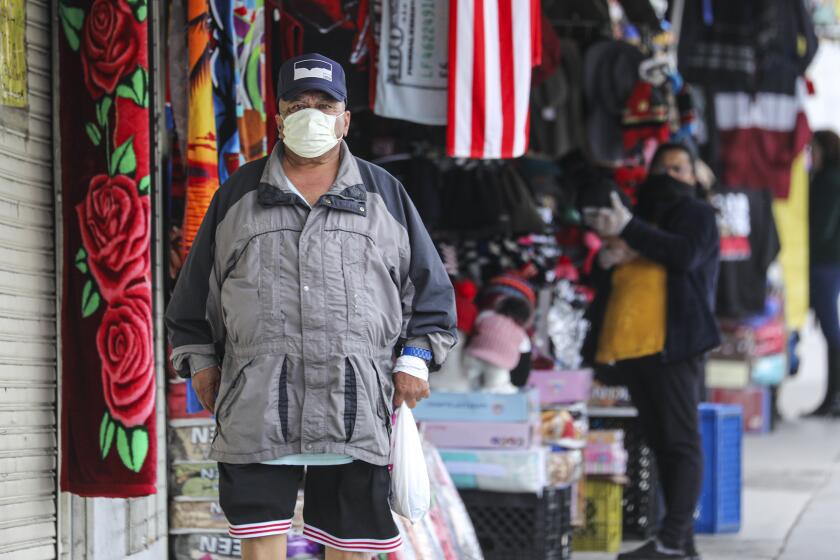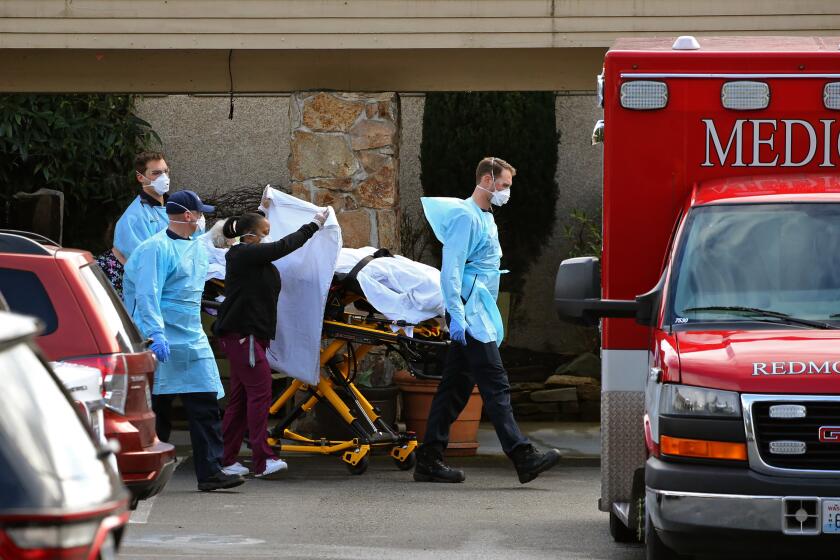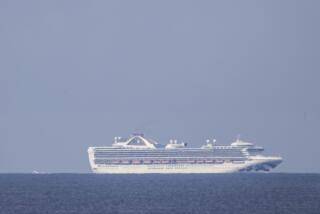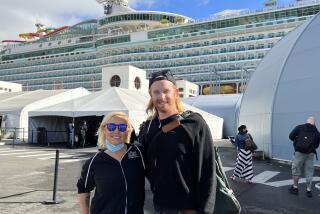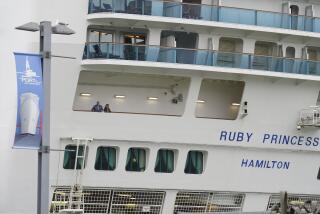Grand Princess passengers still in limbo amid debate over origin of coronavirus outbreak
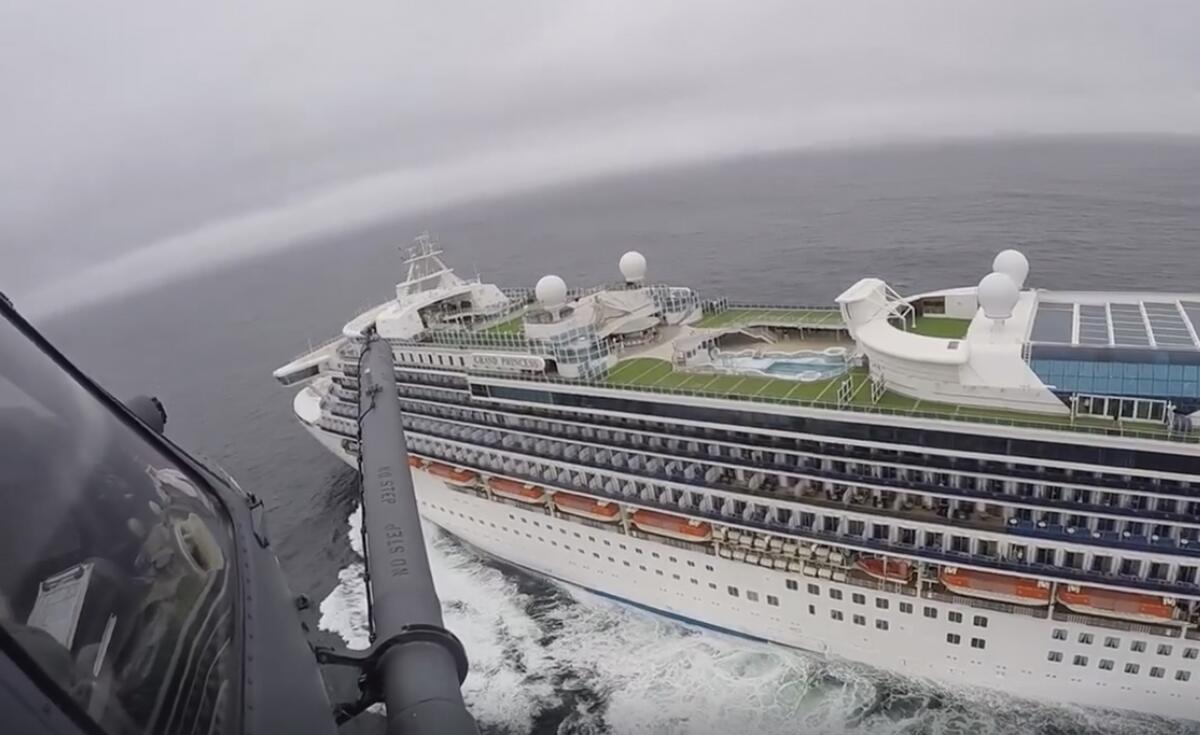
Thousands of passengers remained on a cruise ship held off the coast of San Francisco on Saturday as officials debated the origins of the coronavirus outbreak that has prevented them from disembarking.
The fate of the Grand Princess has become a significant public health challenge, with a dozen coronavirus cases in California linked to passengers who traveled on the ship to Mexico last month. They include a Placer County man who died of COVID-19 on Wednesday.
At least 21 of the nearly 3,000 people who subsequently took the same ship to Hawaii have tested positive for the virus. All of those passengers remain on board, and many more still need to be tested. It’s unclear what will happen to those who are found to be sick.
Get the latest coronavirus updates from our staff in California and around the world.
A cruise line medical officer said Saturday that the man who died brought the virus with him when he boarded the Grand Princess — a point public health officials disputed.
Dr. Grant Tarling, the cruise’s medical officer, said the man — who died at Kaiser Permanente Roseville Medical Center after leaving the ship — sought onboard medical care Feb. 20 and had been sick for several days. Tarling said two waiters who served the man multiple times were subsequently infected.
If true, it could mean there was so-called community spread of the virus in California earlier than had previously been detected.
Placer County’s health officer, however, questioned Tarling’s statement and said the passenger probably contracted the coronavirus that causes COVID-19 while on the cruise.
“Placer County Public Health has been consistent in our message that our first COVID-19-related fatality likely contracted the disease during international travel to Mexico,” Dr. Aimee Sisson said. “As is standard public health practice, we have based our assessment on the information learned in our contact investigation as well as what we know to be true about the disease pattern.”
Though Princess Cruises officials indicated the short period between the Placer County man boarding the ship and the onset of his symptoms suggested he brought the virus on board, the incubation period for COVID-19 is still unknown. The World Health Organization puts it between one and 14 days, most commonly around five days.
Dr. Thomas Frieden, former head of the Centers for Disease Control and Prevention during the Obama administration, agreed the average incubation period was five to six days, with a range between two days and two weeks.
“We don’t yet know when people who have symptoms are infectious, and for how long,” Frieden said.
Tarling said he was basing his assertion that the Placer County man contracted the virus in California before boarding the ship on the five- to six-day average incubation period.
The 75-year-old Placer County man said his symptoms began two to three days after boarding the Grand Princess, according to Tarling.
Coronavirus cases had been confirmed in California as early as January, tied to travel from China.
President Trump has expressed concern that allowing passengers to leave the ship would put the U.S. at risk of accelerating the coronavirus’ spread. Federal and state officials have grappled with how to deal with the cruise ship, where 19 crew members and two passengers have tested positive for the virus.
Vice President Mike Pence said Saturday that officials have developed a plan for passengers that will be implemented this weekend.
“All passengers and crew will be tested for coronavirus and quarantined as appropriate,” he said in a meeting with cruise line executives and port directors in Fort Lauderdale, Fla. “Those that require additional medical attention will also receive it.”
A spokesman for Life Care Center of Kirkland said Saturday that 13 residents who have died tested positive for COVID-19. Eleven more residents died, he said, but autopsy results are not yet available to determine whether they had coronavirus.
But few other details have been released about the plan.
Across the state, 88 people had been infected with the virus as of Saturday morning. In the U.S., there have been at least 428 confirmed cases, with most in Washington state, where 108 people have tested positive and 16 have died. More than 100,000 people have been infected worldwide, according to the World Health Organization.
In California, it is the Grand Princess cruise ship that has been causing worry of a more widespread outbreak.
By Saturday, the state said a dozen passengers of the Grand Princess cruise that returned to San Francisco on Feb. 21 had tested positive for the virus. Local officials reported four cases in Placer County, two in Contra Costa County, two in Sonoma County and one each in Santa Cruz, Ventura, Madera and Alameda counties tied to the cruise.
The Placer County man who sailed to Mexico is the state’s only confirmed COVID-19 fatality.
The Grand Princess was returning from Hawaii when it was held off the California coast. With testing still underway, officials don’t know how many of the more than 3,000 people on board have the virus.
Friday evening, gloves and masks were delivered to the cruise ship by helicopter, according to Negin Kamali, a spokeswoman for the Princess Cruises company. On Saturday morning, a critically ill passenger and their companion were evacuated from the ship by a Coast Guard cutter.
“They are being transported to a shoreside medical facility for treatment unrelated to COVID-19,” Kamali said. “The captain of Grand Princess and the Princess Cruises port operations team continue to await specific directives from state and local response operations about where the ship will proceed.”
Pence, who leads the task force in charge of the response, said the federal government is working with the state of California to bring the cruise ship into a noncommercial port over the weekend and quarantine those on board as necessary.
Trump said he would ultimately let Pence decide whether to allow passengers to leave the ship. But he said several times that he would be inclined to leave them on board because bringing them ashore would increase the number of official cases on American soil.
Passengers on the vessel — both current and those who may have been exposed earlier — told the Los Angeles Times that the response to the outbreak by the company and health officials had been filled with missteps.
In particular, passengers said Princess Cruises was lax on health screening protocols prior to boarding and withheld information about the risks they faced, even as the ship’s situation became international news.
At a White House briefing, federal public health officials could not say precisely how many people have been tested for the virus.
They said 5,861 specimens have been taken by federal, state and local public health labs. Most patients give at least two samples, one from the nose and a second from the throat.
Dr. Stephen Hahn, commissioner of the Food and Drug Administration, promised a massive expansion of testing availability in the coming days. The CDC has shipped out 75,000 tests to public labs in 48 states and 1.1 million tests to commercial labs, with another 1 million tests going out Monday.
That’s enough for roughly 850,000 patients under the current protocols.
Meanwhile, at the Long Beach harbor Saturday, passengers aboard the Carnival Panorama cruise ship were not allowed off the vessel while officials dealt with a “medical matter,” according to a Facebook post by the cruise director.
Long Beach city officials said on Twitter that a passenger aboard the ship was taken to a hospital and is being tested for the coronavirus. According to the cruise director, the passenger did not meet the CDC criteria for coronavirus risk.
The ship is docked at a Long Beach terminal, but “in an abundance of caution, [the CDC] has decided to hold passengers on board until the patient can be evaluated,” the city of Long Beach account tweeted.
Siehara Kennedy, who is aboard the cruise ship, said passengers have been waiting more than three hours to get off. Passengers are not being isolated in their rooms and have been allowed to gather in the ship’s bars and casino, she said.
Elsewhere in the state, concerns over the coronavirus have led to canceled classes and events. The Elk Grove Unified School District, the largest in Northern California, announced Saturday it would close schools and cancel all student activities — including a prom — for a week to buy time and decide next steps.
Supt. Chris Hoffman said no students have tested positive for the virus, but some parents and family members have.
“I don’t know where this is going,” he said in a news conference. “I don’t know that anybody knows where it’s going.”
Washington state, where 108 people have been infected, appears to be bearing the brunt of the U.S. outbreak. Fourteen of the state’s 16 deaths are connected to the Life Care Center of Kirkland, a long-term care facility, according to Seattle & King County Public Health. Officials said 15 people in the nursing facility have been hospitalized in the last 24 hours.
In New York, Gov. Andrew M. Cuomo declared a state of emergency Saturday after the number of confirmed coronavirus cases in the state rose to 76.
Times staff writers Richard Winton, Soumya Karlamangla, Taryn Luna and Richard Read contributed to this report.
More to Read
Sign up for Essential California
The most important California stories and recommendations in your inbox every morning.
You may occasionally receive promotional content from the Los Angeles Times.
